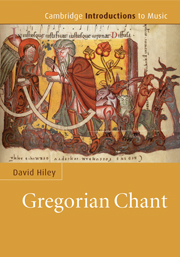Book contents
- Frontmatter
- Contents
- List of illustrations
- List of musical examples
- Note on the musical examples
- List of tables
- List of text boxes
- Preface
- Note on front cover illustration
- Chapter 1 Gregorian chant in the service of the church
- Chapter 2 The beginnings of Gregorian chant; other rites and other sorts of chant
- Chapter 3 Tradition and innovation in medieval chant: from the ninth to the sixteenth century
- Chapter 4 Thinking about Gregorian chant in the Middle Ages, and notating it
- Chapter 5 New chants for new times: from the sixteenth century to the present; aspects of performance
- Map of places from which important medieval chant manuscripts are preserved
- Chronological table
- Statistical table of chant categories by mode
- Original manuscript sources for musical examples
- Glossary
- Bibliography
- Index
Chapter 3 - Tradition and innovation in medieval chant: from the ninth to the sixteenth century
Published online by Cambridge University Press: 05 October 2014
- Frontmatter
- Contents
- List of illustrations
- List of musical examples
- Note on the musical examples
- List of tables
- List of text boxes
- Preface
- Note on front cover illustration
- Chapter 1 Gregorian chant in the service of the church
- Chapter 2 The beginnings of Gregorian chant; other rites and other sorts of chant
- Chapter 3 Tradition and innovation in medieval chant: from the ninth to the sixteenth century
- Chapter 4 Thinking about Gregorian chant in the Middle Ages, and notating it
- Chapter 5 New chants for new times: from the sixteenth century to the present; aspects of performance
- Map of places from which important medieval chant manuscripts are preserved
- Chronological table
- Statistical table of chant categories by mode
- Original manuscript sources for musical examples
- Glossary
- Bibliography
- Index
Summary
This chapter explains how church musicians built upon the Roman-Frankish foundation, responding to the changing and expanding needs of the church in the high Middle Ages, and how the newly composed chant often reflected different stylistic concepts. Most writers on chant would prefer not to think of the new music as ‘Gregorian’ at all. Of the types of chant discussed below, the new Office music might be called ‘neo-Gregorian’, because at least the forms of antiphon and responsory are traditional, even if the melodies become increasingly untraditional. But sequences, tropes, the new Latin songs and the representational ceremonies (‘liturgical dramas’) are categorically un-Gregorian.
Adapting the model to suit present needs: local enhancement of the repertory, new types of chant
However successful the Franks may have been in adopting Roman liturgical practice and its chant, they still had to supplement it with a considerable amount of new material. They venerated a number of saints unknown to the Romans, and needed to find chants to sing on the corresponding holy days. Other new festival days came into the calendar, such as All Saints' Day (1 November) and Trinity Sunday (a week after Whitsunday). Then there were a number of special ceremonies, which the Franks had used of old and which they wanted to retain. The chants for these occasions, if by good fortune they have been preserved in readable notation, sometimes look different in style from ‘classical’ Gregorian.
- Type
- Chapter
- Information
- Gregorian Chant , pp. 121 - 161Publisher: Cambridge University PressPrint publication year: 2009



